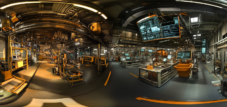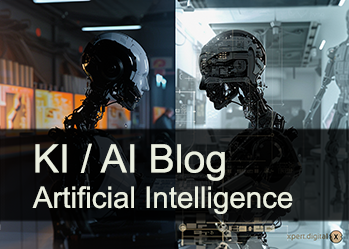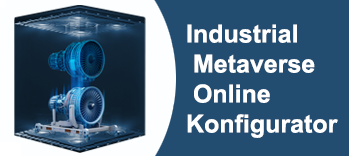Is Silicon Valley overrated? Why Europe's old strength is suddenly worth its weight in gold again – AI meets mechanical engineering
Xpert pre-release
Language selection 📢
Published on: August 4, 2025 / Updated on: August 4, 2025 – Author: Konrad Wolfenstein

Is Silicon Valley overrated? Why Europe's old strength is suddenly worth its weight in gold again – AI meets mechanical engineering – Image: Xpert.Digital
No screws, no AI: Why physical production is the foundation of our digital future
What does it mean to say that physical production is the basis of digital value creation?
Physical production forms the foundation for digital value creation, because without material goods and real production processes, digital transformation would not be possible. This is particularly evident in the modern economy: Digital technologies such as artificial intelligence, big data, and the Internet of Things require physical infrastructure such as data centers, semiconductors, and production facilities. The virtual value chain is ultimately based on the physical value chain and complements it with digital processes and information flows.
The connection between the physical and digital worlds is particularly evident in Industry 4.0, where cyber-physical systems bridge the gap between the two. These systems connect physical production facilities with digital control systems, thus enabling intelligent, networked production. Without the physical foundation – machines, sensors, actuators – digital innovations would not be feasible.
How does Europe, with Germany, position itself compared to the USA, with California and Silicon Valley, in terms of physical production?
With a 5.3 percent share of global production, Germany ranks fourth, making it the leading manufacturing location in Europe. German industry contributes 19.7 percent to national gross value added, while in the United States this share is only 16.8 percent. These figures underscore Germany's strong industrial base compared to other developed economies.
Germany's strength lies in the diversity of its industrial sectors. The four dominant industries – automotive, mechanical engineering, chemicals, and electrical engineering – together employ over 8 million people. Mechanical engineering alone, with 1.3 million employees, is Germany's largest industrial sector and is characterized by a medium-sized enterprise structure that combines flexibility and innovative strength.
In contrast, Silicon Valley specializes primarily in digital services and software development. While the production of physical goods such as microchips and computers has increasingly been relocated to low-wage countries, the region focuses on knowledge-intensive tasks such as development and marketing. This development demonstrates that Silicon Valley has largely abandoned its physical production base in favor of purely digital value creation.
According to Safeguard Global, Germany ranks fourth in the global rankings, accounting for 5.3 percent of global production. The ranking of the top manufacturing countries worldwide is as follows:
- China: 28.7% of global production
- USA: 16.8% of global production
- Japan: 7.5% of global production
- Germany: 5.3% of global production
For comparison:
- EU: 17% of global production
- California: 1.9% of global production
California accounts for 11.4 percent of U.S. industrial production. California's GDP was $4.1 trillion in 2024, approximately 14 percent of U.S. GDP. Silicon Valley has a regional GDP of $467 billion (2019), equivalent to 5.3 percent of U.S. national GDP.
Suitable for:
- A high song in Germany and the EU – why they need themselves to be able to survive against the USA and China
What concrete advantages does Europe have from its strong physical production base?
Europe benefits from a highly developed and diversified industrial structure that serves as the backbone of its economy. The German starch industry, for example, processes 4.2 million tons of plant-based raw materials annually, accounting for almost 20 percent of EU production. This industry exemplifies how physical production enables innovative applications in a wide range of sectors – from food to paper to bio-based plastics.
The close integration of research and production in Europe creates a decisive competitive advantage. German companies invest an average of 3 percent of their turnover in research and development. These investments flow directly into improving production processes and developing new technologies. The export quota of 48.7 percent in the manufacturing sector demonstrates the international competitiveness of European production.
Another advantage is the regional distribution of industry. Germany's strength lies in the diversity of its regions, with rural areas also serving as important locations for industry and trades. This decentralized structure creates stable jobs across the region and prevents the concentration of economic activity in a few metropolitan regions, as is the case in Silicon Valley.
Market size: EU versus USA
How big is the EU market compared to the US market?
The EU internal market encompasses more than 450 million citizens and 22 million companies from 27 countries, making it the largest single market in the world. By comparison, the US is currently estimated to have a population of approximately 347.3 million. This means that the EU market offers approximately 100 million more potential consumers than the US market.
The economic importance of the EU's internal market is also reflected in its economic output of almost 16 trillion US dollars, making it the world's second-largest economic area after the USA. Trade within the EU and with the rest of the world accounts for almost a third of total global trade. Since its entry into force, the internal market has increased the GDP of its member states by between 12 and 22 percent and created more than 2.7 million new jobs.
What are the benefits of the EU’s larger population?
The EU's larger population creates a single sales market, enabling companies to achieve significant economies of scale. Companies can sell their products across all 27 member states without trade barriers. This significantly reduces complexity and costs, as uniform standards and norms apply. Without the single market, companies would have to comply with different regulations in each member state – an immense burden that would be almost impossible to manage, especially for small and medium-sized enterprises.
The larger market also promotes innovation and competition. With 450 million potential customers, investments in new technologies and product developments are more worthwhile than in smaller, fragmented markets. This is particularly evident in the development of Industry 4.0 technologies, where European companies can develop for a domestic market of over 500 million people.
Population size also has a positive impact on labor availability. Free movement of people within the EU allows companies to recruit skilled workers from a pool of 450 million people. This is particularly important for specialized industries that require highly skilled workers.
How does market size affect competitiveness?
Market size is a crucial factor for global competitiveness. The EU's single market enables European companies to achieve the critical mass necessary to compete in global markets. This is particularly evident in capital-intensive industries such as the automotive industry or mechanical engineering, where high development costs must be spread across large volumes.
The size of the single market also strengthens the EU's negotiating position in international trade. As one of the world's most powerful trading blocs, the EU can negotiate on an equal footing with other global trading powers such as the US and China. This provides European companies with better access to international markets.
However, the EU is not yet fully exploiting its potential. Despite formal unity, barriers remain that fragment the internal market. Companies are faced with diverging national legal frameworks, high administrative burdens, and, in some cases, a lack of mutual recognition of standards. Overcoming these barriers could bring the EU up to €1.1 trillion, or up to 8.6 percent, in additional GDP.
🎯🎯🎯 Benefit from Xpert.Digital's extensive, fivefold expertise in a comprehensive service package | R&D, XR, PR & SEM

AI & XR-3D-Rendering Machine: five times expertise from Xpert.digital in a comprehensive service package, R&D XR, Pr & SEM – Image: Xpert.digital
Xpert.Digital has in-depth knowledge of various industries. This allows us to develop tailor-made strategies that are tailored precisely to the requirements and challenges of your specific market segment. By continually analyzing market trends and following industry developments, we can act with foresight and offer innovative solutions. Through the combination of experience and knowledge, we generate added value and give our customers a decisive competitive advantage.
More about it here:
Digital transformation and value creation: Opportunities for Europe's production networks
Industry 4.0 and the future of production
What does Industry 4.0 mean for European production?
Industry 4.0 refers to the intelligent networking of machines and processes in industry through modern information and communication technologies. This represents a fundamental shift for European manufacturing: In the factory of the future, intelligent machines will independently coordinate production processes, service robots will assist humans with heavy-duty tasks, and driverless transport vehicles will independently manage logistics and material flow.
The implementation of Industry 4.0 in Europe is already showing concrete success. In Germany, there are hundreds of users using digital solutions in production. Over 400 practical application examples demonstrate how companies and research institutions are developing and implementing these technologies. The focus is on the merging of the virtual and real worlds, with cyber-physical systems bridging the gap between the two.
German mechanical engineering, in particular, is taking a pioneering role. As a supplier of intelligent production systems, it is at the heart of Industry 4.0 development. Approximately 11.8 percent of all mechanical engineering companies consider themselves pioneers in the development of new digital production technologies. With an export quota of 76 percent and 57 percent of exports outside the EU, mechanical engineering acts as a global ambassador for Industry 4.0.
How far has the implementation of Industry 4.0 progressed in Europe?
Despite the great potential and high expectations, a recent study shows that no company in Germany has yet fully implemented Industry 4.0. While almost 96 percent of companies see the growing importance of Industry 4.0 in production, and over 81 percent plan to invest in this area, many companies are still in the early stages of this revolution.
The technological focus reveals the current state: 73 percent of companies are still concentrating on automating manual process steps, 69 percent on vertical integration for data acquisition, and 58 percent are considering implementing cloud solutions. This shows that many companies are still taking basic digitalization steps before they can move on to advanced Industry 4.0 applications.
The Industry 4.0 platform, the world's largest network for digital transformation in industry, is working to accelerate this development. The platform's experts develop solutions for practical implementation and create standards that enable widespread application.
What role do cyber-physical systems play in modern production?
Cyber-physical systems (CPS) are at the heart of Industry 4.0 and enable the merging of the physical and digital worlds. These systems consist of networked components that can perceive their environment via sensors, process this data, and influence their environment via actuators. In production, this creates cyber-physical production systems (CPPS), which consist of flexible, autonomous, and self-configuring production resources.
The advantages of these systems are manifold. They enable decentralized production control, where decisions are made where they are most efficient. Products can be customized at the cost of mass-produced products. Networking makes it possible to optimally adapt production processes to new requirements, not only within a company, but also between companies, customers, and factories across Europe.
A concrete example is matrix production, in which process modules are arranged in a checkerboard pattern and can be accessed freely. These systems can be flexibly reconfigured when quantities change or new product variants are added. The automotive, electronics, and semiconductor industries are already using such systems to increase adaptability while maintaining high productivity.
Suitable for:
The role of digital transformation
How does digitalization change value chains?
Digitalization is leading to a fundamental redesign of value chains. Traditional linear processes are being replaced by networked, flexible structures. In digital value creation, individual physical processes can be supplemented or replaced by information-based processes. This enables real-time control and optimization across the entire supply chain.
The integration of digital technologies creates new opportunities for value creation. Companies can now collect, analyze, and use data along the entire production chain for optimization. This leads to greater transparency, better planning, and the ability to respond quickly to changes. Customer orders can be processed at short notice, and changes are even possible during the production process.
Particularly important is the emergence of platform ecosystems that connect various actors in the value chain. These platforms enable the flexible distribution and use of functionalities and services. This allows small and medium-sized enterprises to benefit from economies of scale and gain access to advanced technologies.
Which basic technologies are driving digital transformation?
Digital transformation is being driven by several key technologies. The Internet of Things (IoT) forms the basis for the networking of machines, products, and systems. By 2030, the number of digitally networked IoT objects is expected to increase from the current 27 billion to 125 billion. This networking enables continuous data exchange and real-time control of production processes.
Big data and analytics play a central role in processing the enormous amounts of data generated in digitalized production. These technologies make it possible to gain valuable insights from the collected data and continuously optimize production processes. Mass data-based forecasting enables forward-looking maintenance and the prevention of downtime.
Artificial intelligence is increasingly becoming the driving force of digital transformation. AI systems can recognize complex patterns, make decisions, and control processes autonomously. In production, AI enables process optimization, real-time quality control, and the prediction of maintenance needs. The development of AI agents that can think, plan, and act independently will further revolutionize the production landscape.
How important is physical infrastructure for the digital economy?
Physical infrastructure forms the indispensable foundation of the digital economy. This is particularly evident in the enormous demand for data centers for AI applications. In the US alone, investments of up to $500 billion are planned for AI infrastructure, including the construction of supercomputer factories and data centers. These physical facilities are necessary to meet the increasing demands for computing power.
The need for physical infrastructure will continue to grow due to new developments such as reasoning models. These AI models require significantly more computing power than traditional systems because they think through complex tasks step by step. Experts predict that the world will need a hundred times more computing power for advanced AI systems than anticipated just a year ago.
The digital economy's dependence on physical production is also evident in the semiconductor industry. Chips have become a key technology for artificial intelligence, and their production requires highly specialized manufacturing facilities. The concentration of chip production in a few regions, particularly Taiwan, highlights the strategic importance of physical production capacity for the digital future.
Comparison of strengths: Europe versus USA
What are the specific strengths of European industry?
European industry is characterized by its broad diversification and deep roots in various sectors. Germany alone boasts an industrial structure that ranges from traditional sectors like mechanical engineering to cutting-edge fields like electrical engineering. This diversity creates resilience and makes it easier to absorb economic fluctuations in individual sectors.
A particular advantage is the close connection between research and production. European companies, especially in mechanical engineering, sometimes employ more computer scientists than traditional engineers and develop their own operating systems and digital platforms. This integration of IT expertise into traditional industrial companies creates unique innovation potential.
The medium-sized enterprise structure of many European industries proves to be a further advantage. These companies are often highly specialized, flexible, and closely tied to their regional locations. They possess decades of experience and specialized knowledge that cannot simply be copied or relocated. These "hidden champions" are often global market leaders in their niche markets.
What are the strengths of Silicon Valley?
Silicon Valley has established itself as a global center for digital innovation. Its strength lies in its unique combination of top universities like Stanford and Berkeley, a high concentration of venture capital, and a culture of innovation. In 2016 alone, venture capitalists invested $24.9 billion in startups from the Valley.
The region benefits from a dense ecosystem where ideas can be quickly turned into marketable products. The proximity of research, development, and financing creates short paths and enables rapid iterations. This "fail-fast" culture, supported by abundant capital, promotes radical innovations and disruptive business models.
Silicon Valley is a leader in the development of software, artificial intelligence, and digital platforms. Eight of the thirteen global AI unicorns are headquartered here, and 54 percent of global AI investments flowed into Silicon Valley in 2023. This concentration of expertise and resources makes the region the global AI epicenter.
How do physical and digital strengths complement each other in the global economy?
The future lies in the intelligent combination of physical and digital competencies. Europe, with its strong industrial base, and Silicon Valley, with its digital expertise, could complement each other perfectly. This is already evident in the presence of many traditional industrial companies in Silicon Valley, which operate their own labs there to benefit from its innovative power.
The digitalization of industry requires both competencies: the ability to manufacture high-quality physical products and the know-how to intelligently network and control them. European companies that combine their production expertise with digital technologies are creating new business models that go beyond mere software or hardware.
This convergence is particularly evident in areas such as autonomous driving and intelligent manufacturing. This is where Europe's automotive expertise meets Silicon Valley's software expertise. Only by connecting the two worlds can the complex challenges of the future be mastered.
🔄📈 B2B trading platforms support – strategic planning and support for export and global economy with Xpert.digital 💡
Business-to-business (B2B) trading platforms have become a critical component of global trade dynamics and thus a driving force for exports and global economic development. These platforms offer companies of all sizes, in particular SMEs – small and medium -sized companies – that are often regarded as the backbone of the German economy, significant advantages. In a world in which digital technologies come to the fore more and more, the ability to adapt and integrate is crucial for success in global competition.
More about it here:
Hybrid production systems: Europe's key to global competitiveness
Risks of digital business models and the opportunity of Industry 4.0 in Europe
What challenges does European industry face?
European industry is facing several significant challenges. Production figures reveal a worrying trend: In the first half of 2024, industrial production in Germany fell by more than 5 percent year-on-year, and the gap compared to the end of 2019 production level is now 8 percent. This decline particularly affects mechanical engineering and parts of the electrical and automotive industries.
Another problem is the incomplete integration of the single market. Despite formal unity, companies continue to face fragmented regulations, differing standards, and bureaucratic hurdles. These obstacles create additional costs and prevent European companies from harnessing the full power of the 450 million-strong market.
Energy costs represent an additional burden. High energy prices impair the competitiveness of energy-intensive industries. At the same time, companies face the challenge of decarbonizing and making their production sustainable, which requires additional investment.
What risks does focusing on purely digital business models entail?
Focusing on purely digital value creation without a physical basis carries considerable risks. Silicon Valley has already experienced this: The relocation of physical production to low-wage countries led to the loss of manufacturing expertise and jobs. Today, the region is almost entirely dependent on imports of physical goods.
The dependence on global supply chains became painfully clear during the COVID-19 pandemic. Production disruptions, particularly in China, led to bottlenecks worldwide and demonstrated the vulnerability of purely digital business models without in-house production capacity. This prompted some companies to rethink their production strategies.
Another risk is social inequality. In Silicon Valley, high salaries in the tech industry lead to extreme living costs and a growing gap between rich and poor. The concentration on high-skilled jobs crowds out other employment opportunities and creates social tensions.
What opportunities arise from combining both approaches?
The integration of physical and digital competencies opens up enormous potential. Industry 4.0 demonstrates how the combination of traditional manufacturing expertise with digital technologies leads to entirely new possibilities. Companies can produce customized products at the cost of mass-produced products while responding flexibly to customer needs.
Digital technologies make the relocation of production back to Europe economically viable. Automation and intelligent control can offset higher labor costs. At the same time, new, highly skilled jobs are being created at the intersection of production and digitalization.
The circular economy particularly benefits from the combination of physical and digital technologies. Digital product passports and tracking systems enable better traceability and reuse of materials. This not only creates ecological benefits but also new business models in the circular economy.
Suitable for:
Europe’s opportunity in and with production: How hybrid systems combine physical and digital
How could the relationship between physical and digital production develop?
The future will be characterized by an increasing merging of physical and digital production. Experts predict that the strict separation between the two will become obsolete. Instead, hybrid systems will emerge in which physical products are developed with digital twins from the outset and digitally supported throughout their entire lifecycle.
The development of cyber-physical matrix production systems points the way. These systems enable flexible, self-organizing production that automatically adapts to changing requirements. The physical production infrastructure becomes an intelligent, networked platform capable of efficiently manufacturing various product variants and quantities.
New technologies such as additive manufacturing (3D printing) and AI-driven robotics will further blur the boundaries between digital planning and physical implementation. Products can be manufactured directly from digital models, with AI systems calculating and adjusting optimal production parameters in real time.
What role will Europe play in the future global economy?
Europe has the potential to play a leading role in the integration of physical and digital value creation. With its strong industrial base, large internal market, and increasing digitalization, the continent has ideal conditions. The development of a common European industrial strategy could pool these strengths and leverage them globally.
The new EU industrial strategy focuses on combining decarbonization and digitalization. The "Clean Industry Deal" mobilizes over €100 billion for the transformation of European manufacturing. These investments aim to make Europe a leader in sustainable production technologies while strengthening competitiveness.
Europe could become a model for balanced economic development that embraces both digital innovation and industrial production. The ability to produce high-quality products sustainably and intelligently will become a decisive competitive advantage in a world of scarce resources and increasing environmental demands.
How can the strengths of both regions be optimally utilized?
Optimally leveraging strengths requires increased cooperation rather than competition. Partnerships between European industrial companies and American tech firms can create synergies. Many German companies already utilize research collaborations in Silicon Valley to gain access to the latest technologies.
The exchange of best practices and the joint development of standards are essential. The Industrie 4.0 Platform and the Industrial Internet Consortium are already working on joint approaches. This cooperation should be expanded to create global standards for digital production.
Investments in transatlantic research projects and joint innovation centers could institutionalize the combination of physical and digital expertise. Both sides should contribute their respective strengths: Europe its manufacturing expertise and sustainability expertise, the US its innovative strength and digital leadership. Only through this combination can the major challenges of the future – from the climate crisis to digital transformation – be successfully mastered.
Your global marketing and business development partner
☑️ Our business language is English or German
☑️ NEW: Correspondence in your national language!
I would be happy to serve you and my team as a personal advisor.
You can contact me by filling out the contact form or simply call me on +49 89 89 674 804 (Munich) . My email address is: wolfenstein ∂ xpert.digital
I'm looking forward to our joint project.

























